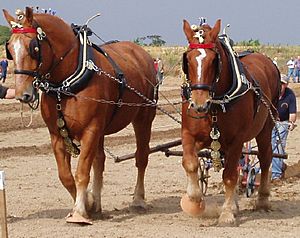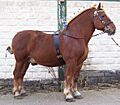Suffolk Punch facts for kids

Suffolk Punch horses
|
|
| Distinguishing features | Heavy draught horse, always chestnut in colour |
|---|---|
| Alternative names | Suffolk |
| Country of origin | England |
| Breed standards | |
| Suffolk Horse Society (England) | Breed standards |
| American Suffolk Horse Association (US) | Breed standards |
| Horse (Equus ferus caballus) | |
The Suffolk Horse, also known as the Suffolk Punch, is a special horse from England. It's a type of draught horse, which means it's bred to pull heavy things. The first part of its name comes from the county of Suffolk in East Anglia. The word "Punch" describes its strong, solid look. These horses are always a chestnut colour, which is a reddish-brown. The people who keep track of the breed, called breed registries, traditionally spell it "chesnut" without the "t" in the middle. Suffolk Punches are known as "good doers," meaning they don't need a lot of food to stay healthy. They also have energetic ways of moving, called gaits.
This breed started developing in the early 1500s. It still looks very similar to its first ancestors. The Suffolk Punch was created mainly for farm work. It became very popular in the early 1900s. However, as farms started using more machines, the breed became less popular. Its numbers dropped so much that it almost disappeared completely. Today, groups like the UK Rare Breeds Survival Trust and the American Livestock Breeds Conservancy say the breed is in a "critical" state, meaning it's still very rare. But thankfully, more people are becoming interested in them, and their numbers are slowly growing again. In the past, these horses pulled artillery (big guns) and non-motorized vans and buses. They also did a lot of farm work. They were even sent to other countries to improve local horse breeds. Today, Suffolk Punches are used for pulling work, in forestry, and sometimes for advertising.
Contents
What Makes Them Special?
Suffolk Punches are usually between 16.1 and 17.2 hands tall. This means they are about 165 to 175 centimetres tall at the shoulder. They weigh around 1980 to 2200 pounds (900 to 1000 kg). As mentioned, they are always a chestnut colour. This colour can range from very dark to bright red or light brown. Horse breeders in the UK use special names for these shades, like dark liver, dull dark, red, and bright. It's rare for them to have white markings. If they do, these are usually small spots on their face or lower legs. A famous horse writer, Marguerite Henry, once said their colour was "like a tongue of fire" against farm fields.
The Suffolk Punch is often shorter but more strongly built than other British heavy horses. For example, they are different from the Clydesdale or the Shire. This is because they were bred for farm work, not for pulling things on roads. They have a strong, curved neck and powerful, sloping shoulders. Their back is short and wide, and their rear is muscular and broad. Their legs are short and strong, with wide joints. They have good, well-shaped hooves. They also have very little "feathering" (long hair) around their fetlocks (ankles). Suffolk Punches are known for their energetic movement, especially when they trot. They tend to grow up quickly and live a long time. They are also "economical to keep," meaning they don't need as much food as other large horses. They are very hard workers. People used to say they would "pull a heavily laden wagon till [they] dropped."
In the past, some people thought the Suffolk's hooves were too small for its body. But this problem was fixed. Horse shows started having special classes where the shape and strength of their hooves were judged. This unique practice helped improve the breed's feet. Now, Suffolk Punches are known for having excellent hooves.
A Look at Their History
The Suffolk Punch has the oldest breed society in England. The first time this horse was mentioned was in a book called Britannia in 1586. The book described a working horse in eastern England that sounds just like the Suffolk Punch we know today. This means they are the oldest horse breed that still looks the same now as it did centuries ago. Studies show that the Suffolk Punch is closely related to British ponies like the Fell and Dales, and also to the European Haflinger. They were developed in a quiet, isolated area of Norfolk and Suffolk. Farmers there needed a horse that was strong, had lots of energy, was healthy, lived a long time, and was easy to handle. They bred the Suffolk Punch to have all these qualities. Because farmers used these horses on their own land, they rarely sold them. This helped keep the breed's bloodlines pure and unchanged.
The main ancestor of today's Suffolk Punch was a stallion (male horse) born in 1768. He was owned by Thomas Crisp. At that time, the breed was called the Suffolk Sorrel. This special horse was never given a name and is just known as "Crisp's horse." By the 1760s, all other male lines of the breed had died out. This meant that almost all Suffolk Punches today come from this one horse.
In 1784, the breed was described as about 15 hands high. They were short and strong, with bony legs. They were often light sorrel (chestnut) in colour, gentle, and powerful. Over time, other breeds like the Norfolk Trotter, Norfolk Cob, and later the Thoroughbred influenced the Suffolk. The reason they all have a uniform chestnut colour comes partly from a small trotting stallion named Blakes Farmer, born in 1760. Some people tried to crossbreed other horses with the Suffolk Punch to make them bigger. But these attempts didn't have a lasting effect. The breed still looks much like it did before any crossbreeding.
The Suffolk Horse Society was started in Britain in 1877 to promote the Suffolk Punch. They published their first book of registered horses in 1880. The first official Suffolk horses were sent to Canada in 1865. In 1880, the first Suffolks arrived in the United States. More came in 1888 and 1903 to start breeding them there. The American Suffolk Horse Association was created and published its first stud book in 1907. By 1908, Suffolk Punches had also been sent from England to many other countries. These included Spain, France, Germany, Australia, and Argentina.
During the First World War, the Suffolk Punch became a very popular workhorse on large farms. This was because of its good nature and strong work ethic. It stayed popular until the Second World War. During the war, many horses were sent away. After the war, farms started using more machines. This caused the number of Suffolk Punches to drop greatly. In 1966, only nine foals (baby horses) were registered in Britain. But since the late 1960s, people have become interested in the breed again. Their numbers have been slowly rising ever since. Even so, the breed remained rare. In 1998, there were only 80 breeding mares (female horses) in Britain. These mares produced about 40 foals each year. In the United States, the American Suffolk Horse Association stopped working for 15 years after the war. But it started up again in 1961 as the market for draught horses began to recover.
As of 2001, horses bred with American bloodlines could not be registered with the British Association. The Suffolk Punch was considered the rarest horse breed in the United Kingdom. Even though the population has grown, the Rare Breeds Survival Trust in the UK still calls their survival status "critical." In 2011, there were between 800 and 1,200 horses in the United States. There were about 150 in England. The American Livestock Breeds Conservancy also lists the breed as critical. In 2007, the Suffolk Horse Society recorded 36 purebred foals born. By 2016, there were about 300 Suffolk Punches in the UK. Around 30 to 40 purebred foals are born each year.
How They Are Used Today
The Suffolk Punch was mainly used for pulling heavy things on farms. But they also often pulled heavy artillery during wartime. Like other heavy horses, they were used to pull non-motorized vans and other commercial vehicles. Today, they are used for commercial forestry work. They also do other pulling jobs and are sometimes used in advertising. They are also used for crossbreeding. This helps create strong sport horses for competitions like hunter and show jumping. The local football team, Ipswich Town F.C., even has a Suffolk Punch as a main part of its team badge. This shows how important the horse is to the area.
The Suffolk Punch played a big part in creating the Jutland breed in Denmark. A Suffolk Punch named Oppenheimer LXII was brought to Denmark in the 1860s. He became one of the founding stallions of the Jutland breed. Suffolk horses were also sent to Pakistan in the 1900s. They were used to improve local horse breeds. They have been crossed with Pakistani horses and donkeys to create army horses and mules. Suffolks have done well in Pakistan's climate, even though they are large. This program has been successful. The Vladimir Heavy Draft, a pulling horse breed from the former USSR, was also influenced by the Suffolk.
Images for kids
See also
 In Spanish: Suffolk Punch para niños
In Spanish: Suffolk Punch para niños





